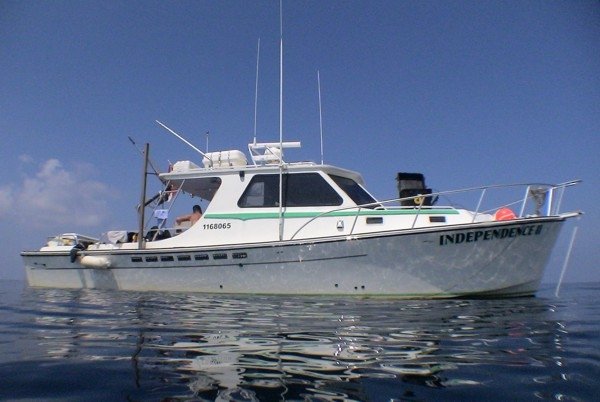 |
| Independence II |
The short answer is: not having your camera, but that’s a story in it self. Today’s dive was to the U-869 AKA the U-who. The Independence was filled with quality NJ divers, but most of them had never been on this wreck. I was diving with a student, Tom, who was also visiting the wreck for the first time.
We headed out early in the flat calm seas left in the wake of Hurricane Bill. We made good time to the wreck. Bill and Brandon went into tie in. It gonfiabili often takes a few minutes since you never do anything fast in 230 fsw. I helped the first group of divers get in, then we geared up. After buddy checks, we reviewed the plan one more time, then splashed.
The surface temp was high 70s, no current, and the water was very clear. Brandon and Bill were hanging, and Brandon took the opportunity to snap off a few of his great shots. If I were not with a student, I would have paused a few moments to give him a model, but Tom was dropping fast, and I wanted to catch up. We passed other groups of divers on the way. Many had lobsters in their bags.
The line was completely slack all the way down to the wreck. No current at any level. This is unusual out here. Often the current changes directions at different levels. There was nothing, anywhere. It was obvious that there were many layers. You could see them as you passed through. The vis would change, and you could see the water go from cloudy to clear to cloudy. Some of the layers were thermoclines, and the temp started dropping. Below 120ft we felt the drop down to 46 degrees. After a few minutes it started to get dark, and I switched on my light. Now I could easily signal my position, and could see my buddy. Tom started slowing his decent. I’m not sure if he was waiting for me, or if he just needed more time to clear his ears. Either way, I caught up.
My gauges indicated that we were within 50 ft of the wreck, but nothing was coming into view. We continued to drop. The faint glow of a strobe lit up the area. The vis had dropped to 10 ft, and the wreck suddenly appeared below us. The chain was wrapped around a cylinder on top of the wreck.
With the short vis, I immediately reached from my reel. I’ve never run a reel on this wreck before, but I did not want to miss the line with a student in tow. Given the depth and conditions, I was concerned that Tom might be nervous. This proved completely unfounded, as he soon grabbed a lobster and put it in his bag. Not that we were here for lobster, but when they are right there, what do you do?
Given the conditions, we swam slowly along the wreck trying to identify anything we could. We reached the Bow, and dropped down the side to the sand 230ft. This was perfect timing for our dive plan as it was time to turn around. We returned slowly to the line and arrived ahead of schedule. With a few minutes left we continued aft, and found that we were tied in just ahead of the break. We quickly inspected the blast area, which contains a jumble of ripped and torn steal, then doubled back to the line.
At this point, I was happy I had run the line. The strobes on the anchor were no longer visible. We were only a few feet away, but could see nothing. For a few seconds your heart skips. Replay your steps. Ok, there it is. I was not so concerned for myself, as my gas plan left me lots of reserve. I never know how conservative a student is with there gas estimates. We reached the line with a minute or two to spare, and signaled UP.
The long slow assent starts. The initial stops are still cold, and now that we are not swimming, the cold can be felt. Clearing the 100 ft stop brought the temp up to 55. That’s a huge change and it felt great. Soon we could see other divers above us. Those we passed on the way down the line, were now hanging at their shallower stops. Above 50 ft the temp jumped back into the 70s and vis was fantastic.
Tom had run his numbers with the VR3, while I was running V-planner. As we discussed, I would have longer deeper stops, and shorter shallow stops. This was more evident that I realized. Most of my early stops, I was 10-20 feet below him. At 40 ft we matched up, then at 20 ft he indicated 10 minutes as I was cleared for the surface.
At some point in this evolution, we were hanging with another four divers around the 20 ft stop. Two divers had ascended the anchor line, while the rest of use went up the Caroline line. Time passes slowly, and we were just hanging there for our stops to clear. I looked down and noticed a very large object moving in the water below us In the clear water, I could easily make out the features of a very large shark. The nose had the distinct features of a basking shark. From above we could not see the mouth, but the snout was unmistakable. I looked to my fellow divers who were transfixed on their gauges. I got their attention, and pointed out the shark. It swam slowly around the Caroline line below us, then doubled back to the anchor line. It swam around the lines in a figure eight, then swam slowly off into the distance. Since it swam between the lines, we knew it was only about 20 ft below us. Comparing its size to the divers on the bow line, I estimate it was a minimum of 20ft. I’ve seen Basking sharks before, but never this clearly. It was an awe inspiring sight!
While we were really psyched at the incredibly cool experience, I was chastising myself for not bringing my camera. Given I was with a student, on a deep dive, I did not want the extra task loading. I was planning on grabbing it after the dive, and snapping a few shots of the other divers entering and leaving the water. Well, I did not have it now, and was quite disappointed! We spent the rest of our decompression looking around for the shark to return, or perhaps one of its school (as Basking sharks are know to swim in schools). No such luck.
Once on the surface, we did talk about the shark, and some asked what type it was. I’m sure it would have been a much more heart pounding experience for those that did not know. I did grab the camera, and swam around the boat taking a few shots. Captain Dan, and Danny jumped in for a dive and to pull the hook. The sea was flat calm, with no current. It was an enjoyable wait just floating in the water.
Before long we were underway for the long trip home. It was a great day, and many will tell the story of seeing a huge basking shark.
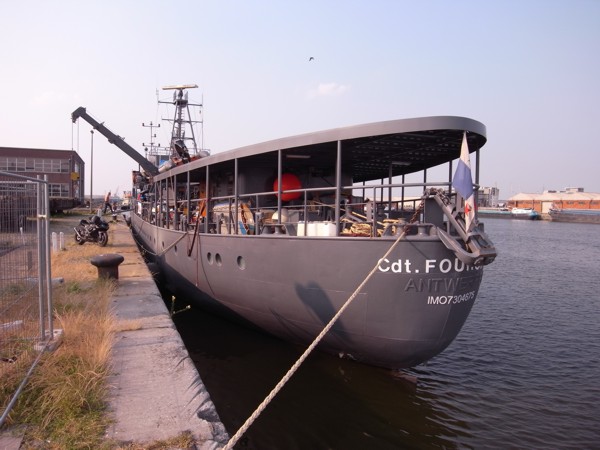
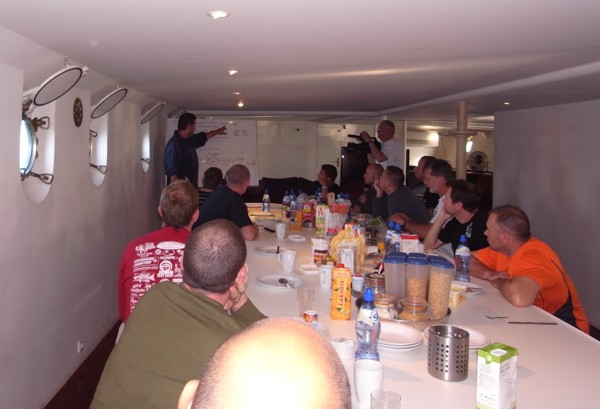
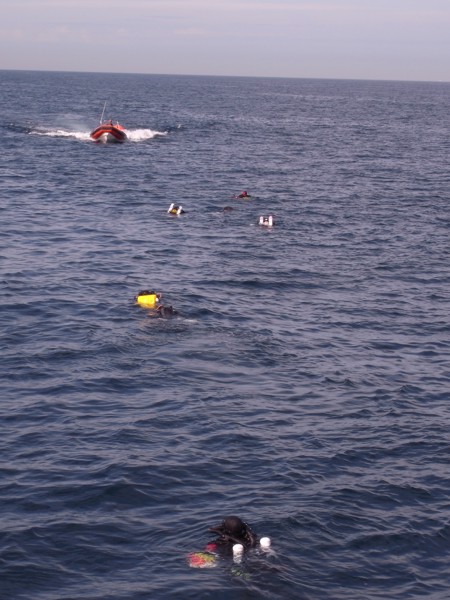
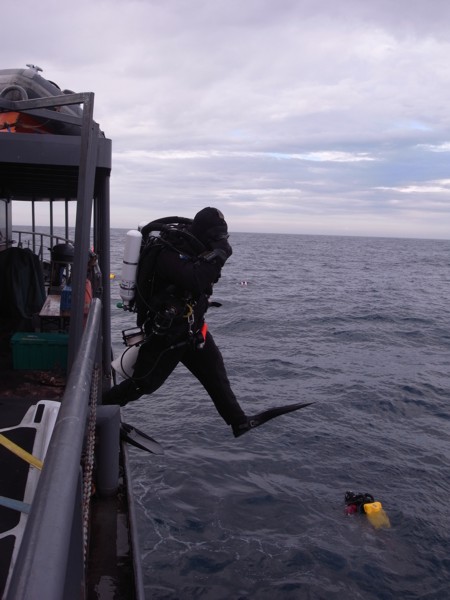
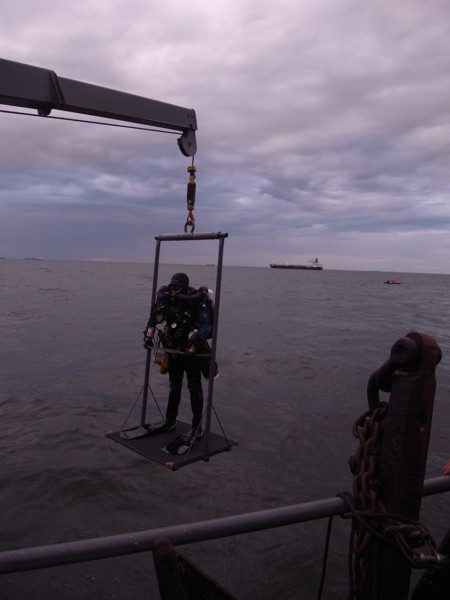
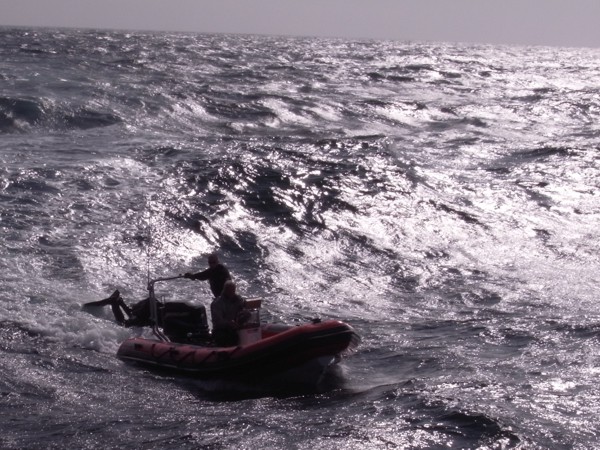
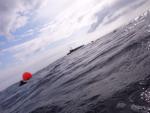 Click the image to see all the slides.
Click the image to see all the slides.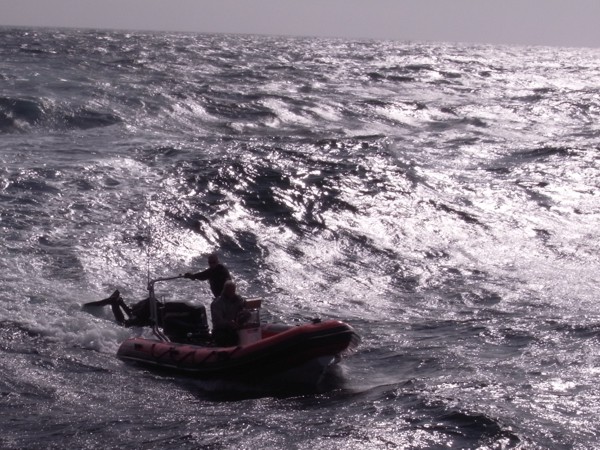 Video: How to board a boat Cdt. Fourcault style!
Video: How to board a boat Cdt. Fourcault style!